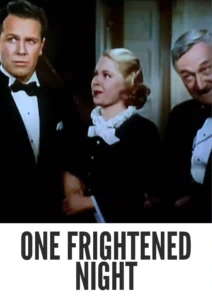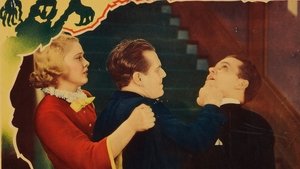Contact: info@alwanfilm.com
Video Sources 0 Views

One Frightened Night 1935 Colorized
Synopsis
Review: One Frightened Night 1935 Colorized – A Classic Mystery in Monochrome

Introduction
One Frightened Night 1935 Colorized stands as a captivating entry in the annals of classic mystery cinema. Directed by Christy Cabanne and featuring a cast of notable character actors of the era, the film offers a thrilling blend of suspense, comedy, and intrigue. Despite being a product of the pre-color era, its gripping narrative and atmospheric tension have ensured its place in film history. In this article, we delve into the story, cast, and lasting impact of “One Frightened Night,” examining how its monochrome presentation enhances its eerie charm.
Check The Full Colorized Movies List
Check Our Colorized Movies Trailer Channel
Understanding One Frightened Night 1935 Colorized: Director, Cast, and Genre
“One Frightened Night” is directed by Christy Cabanne, a prolific filmmaker whose extensive career spanned silent films and talkies. Known for his versatility, Cabanne brought a deft touch to this mystery thriller, crafting a film that combines elements of suspense and dark humor.
The cast of “One Frightened Night” features a stellar ensemble, including Charles Grapewin as Jasper Whyte, the wealthy and eccentric protagonist. Grapewin, best known for his roles in “The Wizard of Oz” and “The Grapes of Wrath,” delivers a memorable performance that anchors the film’s narrative. Supporting him are Mary Carlisle as Gail Richards, Regis Toomey as Tom Dean, and Lucien Littlefield as Dr. Denham. Each actor brings a unique energy to the film, contributing to its dynamic and engaging atmosphere.
Exploring the World of One Frightened Night 1935 Colorized: Plot and Characters
The plot of “One Frightened Night” centers on Jasper Whyte, an elderly millionaire who gathers his relatives and potential heirs at his mansion to announce the distribution of his fortune. As the evening unfolds, a storm traps everyone inside, and the arrival of two women, each claiming to be Jasper’s long-lost granddaughter, sets off a series of mysterious and deadly events.
The film’s structure is reminiscent of a classic “whodunit,” with a confined setting, a cast of suspicious characters, and a string of enigmatic occurrences. Jasper Whyte’s mansion, with its shadowy corners and creaking doors, serves as the perfect backdrop for the unfolding drama. The characters, from the scheming relatives to the enigmatic strangers, each have their own motives and secrets, adding layers of complexity to the narrative.
The Art of Film Noir: Atmosphere and Aesthetics
“One Frightened Night” is a prime example of the early stages of film noir, a genre characterized by its use of shadow, light, and atmospheric tension to create a sense of unease and mystery. The film’s black and white cinematography enhances its eerie ambiance, with deep shadows and stark contrasts highlighting the suspenseful moments.
The monochrome palette of “One Frightened Night” plays a crucial role in building the film’s mood. The interplay of light and darkness, the sharp silhouettes, and the use of chiaroscuro techniques all contribute to the film’s visual storytelling. In the absence of color, the focus shifts to the intricate details of the set design, the actors’ expressions, and the nuanced play of light and shadow, all of which heighten the sense of suspense and drama.
Early Mystery Films: A Brief History
Mystery films have been a staple of cinema since its inception, with early examples drawing inspiration from popular detective stories and stage plays. The genre evolved over time, incorporating elements of suspense, crime, and psychological drama. “One Frightened Night” sits within this tradition, embodying the characteristics of early mystery films while paving the way for future noir classics.
The 1930s saw a proliferation of mystery films, many of which were influenced by the works of authors like Agatha Christie and Arthur Conan Doyle. These films often featured convoluted plots, eccentric detectives, and atmospheric settings, creating a template that would be refined and expanded in the following decades. “One Frightened Night” stands out in this context for its unique blend of humor and suspense, as well as its memorable characters and tightly woven plot.
One Frightened Night 1935 and Its Monochrome Magic
The decision to shoot “One Frightened Night” in black and white was largely dictated by the technological limitations and economic considerations of the era. However, this choice inadvertently contributed to the film’s lasting appeal. The monochrome aesthetic enhances the film’s mystery and tension, drawing viewers into its shadowy world.
The lack of color directs attention to the film’s other visual elements, such as composition, lighting, and texture. This focus on visual storytelling creates a rich, immersive experience that engages the audience’s imagination. The black and white imagery lends a timeless quality to the film, making it a classic that continues to captivate viewers.
The Debate Over Colorization of Classic Films
The colorization of black and white films is a topic of ongoing debate in the film community. Proponents argue that colorization can make classic films more accessible to contemporary audiences, potentially revitalizing interest in older works. Critics, on the other hand, contend that colorization can undermine the artistic integrity and historical authenticity of the original films.
In the case of “One Frightened Night,” colorization could alter the film’s unique atmosphere and aesthetic. The interplay of light and shadow, so crucial to the film’s mood, might be lost or diminished in a colorized version. Moreover, the film’s historical context and the director’s original vision should be preserved and respected, allowing modern audiences to appreciate the artistry of early cinema.
Examining One Frightened Night 1935 as a Monochrome Masterpiece
Viewing “One Frightened Night” as a monochrome film offers a unique insight into the art of visual storytelling. The absence of color places greater emphasis on other cinematic elements, such as lighting, composition, and performance. The film’s use of shadow and light creates a tense, foreboding atmosphere that draws viewers into its mysterious world.
The film’s visual style also highlights the talents of its cast, whose performances are enhanced by the stark, dramatic lighting. Charles Grapewin’s portrayal of Jasper Whyte, for instance, is brought to life through the subtle interplay of light and shadow, which accentuates his character’s eccentricity and depth. Similarly, the film’s intricate set design and carefully crafted compositions contribute to its overall impact, creating a visually compelling experience.
Influence and Legacy: One Frightened Night 1935’s Impact on Cinema
“One Frightened Night” has left an indelible mark on the mystery genre, influencing subsequent films with its blend of suspense, humor, and atmospheric tension. Its legacy can be seen in later works that employ similar narrative structures and visual techniques, as well as in the continued popularity of the “whodunit” genre.
The film’s innovative use of setting and character dynamics has inspired numerous filmmakers, contributing to the evolution of mystery and noir cinema. Its success also underscores the enduring appeal of classic mystery stories, which continue to captivate audiences with their intricate plots and enigmatic characters.
Director’s Cinematic Legacy: Beyond One Frightened Night 1935 Colorized
Christy Cabanne’s extensive filmography includes a diverse range of genres, from silent films and serials to talkies and genre pictures. His work on “One Frightened Night” demonstrates his ability to create suspenseful, engaging narratives, cementing his reputation as a versatile and talented director.
Cabanne’s contributions to early cinema extend beyond “One Frightened Night,” with a career that spans several decades and numerous influential films. His work helped to shape the conventions of genre filmmaking, and his legacy continues to be felt in the world of cinema. By exploring Cabanne’s broader body of work, we can gain a deeper appreciation for his contributions to the art of filmmaking.
Themes Explored in One Frightened Night 1935 Colorized
“One Frightened Night” delves into themes of greed, deception, and the quest for identity, weaving these elements into its suspenseful narrative. The film’s exploration of human nature, with its focus on the darker aspects of ambition and betrayal, resonates with audiences and adds depth to its mystery plot.
The film’s setting—a secluded mansion beset by a storm—serves as a microcosm for these broader themes, trapping its characters in a confined space where their true natures are gradually revealed. The tension between appearance and reality, a hallmark of the mystery genre, is central to the film’s plot, driving the characters’ actions and the story’s twists and turns.
Reception and Controversy Surrounding One Frightened Night 1935 Colorized
Upon its release, “One Frightened Night” received positive reviews for its engaging story, strong performances, and atmospheric direction. Critics praised its blend of humor and suspense, noting its effective use of setting and character dynamics. However, some contemporaries expressed reservations about the film’s pacing and plot complexity.
In the years since its release, “One Frightened Night” has been reevaluated by film historians and enthusiasts, who appreciate its contributions to the mystery genre and its enduring appeal. The film’s status as a cult classic has grown, with modern audiences discovering its unique charm and historical significance.
Where to Watch One Frightened Night 1935 ColorizedOnline
For those eager to experience “One Frightened Night,” the film is available on various streaming platforms, ensuring accessibility to audiences worldwide. Classic film aficionados can find it on services like Amazon Prime Video, YouTube, and other digital libraries, where it remains a must-watch for fans of early mystery cinema.
FAQs About One Frightened Night 1935 Colorized
Common queries surrounding “One Frightened Night” address its plot intricacies, character motivations, and historical context. By answering these frequently asked questions, viewers can gain a deeper understanding of the film’s narrative and thematic layers.
Q: What makes “One Frightened Night” a classic mystery film?
A: The film’s compelling plot, atmospheric setting, and strong performances contribute to its status as a classic mystery. Its blend of suspense and humor, along with its memorable characters, makes it a standout example of early mystery cinema.
Q: How does the film’s black and white cinematography enhance its atmosphere?
A: The monochrome palette creates a sense of tension and unease, emphasizing the interplay of light and shadow. This visual style enhances the film’s suspenseful moments and adds depth to its atmospheric setting.
Q: What themes are explored in “One Frightened Night”?
A: The film delves into themes of greed, deception, and the quest for identity, exploring the darker aspects of human nature. These themes are woven into the narrative, driving the characters’ actions and the story’s twists and turns.
Conclusion
“One Frightened Night” (1935) remains a testament to the enduring power of classic mystery cinema. Its atmospheric tension, engaging plot, and memorable characters continue to captivate audiences, demonstrating the timeless appeal of well-crafted suspense. Whether viewed in its original black and white format or explored through the lens of modern appreciation, the film stands as a landmark in the genre. As we reflect on its legacy and influence, “One Frightened Night” serves as a reminder of the magic of early cinema and the art of storytelling that transcends the bounds of time.











